This week, we put your questions to our expert panel of scientists - what’s the tallest possible building? Do female animals flirt? And what can we do if an asteroid ends up heading for earth?
In this episode

04:34 - Is there a limit to the height of a building?
Is there a limit to the height of a building?
Chris Smith put this question to engineer Allan McRobie...
Allan - I don’t really think there is a maximum height. We’ve already gone almost a kilometre Burj Khalifa. There are lots of proposals…
Chris - Where’s that one?
Allan - The Burj Khalifa is in Dubai. It’s a skyscraper; it’s almost a kilometre tall - 820 metres I think. But the trick to go higher is just to taper like the Eiffel Tower, like the Shard, like the Burj Khalifa is tapered. We’re having a bigger area at the bottom and you can spread the stress out more, so the pyramids are a nice example. You can just sort of keep going and make something the height of Mount Everest, or higher.
Chris - It’s amazing they realised that 5,000 years ago and it’s taken us all that time, in the meantime, to rediscover that.
Allan - Well maybe the other ones fell down.
Chris - I suppose so. Why should having a big base make a difference then? Why is that the way to go?
Allan - It just spreads out the load more so you get smaller pressure, smaller stress, so you can have an average stress all the way up.
Chris - What about the materials basis of this because concrete is wonderful but is it up to the job of continuously taking a load which gets higher and higher and higher? Because the bigger you’re building is the more load the ground at the bottom has got to take, hasn’t it?
Allan - Yes and no. If you spread out as fast as you are adding materials you can keep the stress the same. It works with any material whether it’s concrete, or ice, or marshmallow.
Chris - Sophie?
Sophie - If we’re going to eventually become an environmental constraint in terms of the height of the building - will it get too cold?
Allan - There are lots of constraints like that - the wind and so forth. I think there was a proposal a hundred years ago about a space elevator which was actually to build something all the way into outer space. The proposal’s still going; they're going to do it differently but the original proposal was to build it from from the earth all the way up to a geostationary orbit.
Chris - Were you also referring, Sophie, to the fact that in some countries people are demonstrating that you get significant changes in temperature in the local environment because of the built environment? You get buildings that radiate heat, they absorb heat during the day, they radiate that down at the ground. They also change the way the wind currents flow and this has a local effect on the environment which is not altogether great sometimes.
Allan - I completely agree. Euston Station forecourt for example; the buildings around it you get these local wind effects. You are exactly right there are lots of other things. Can you pour concrete; how do you get your concrete up there? There’s lots of other problems but the basic material problem is there’s basically there’s no limit to how high you can go.
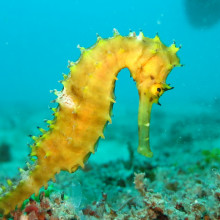
07:06 - Do female animals flirt, or is it just males?
Do female animals flirt, or is it just males?
Chris Smith put this question to behavioural ecologist Sophie Mowles...
Sophie - A lot of this relies on parental care and it’s down to the way in which male and female animals create their gametes, so they’re sex cells, eggs, sperm. From the very start, a female animal has to invest a lot. They have to create a really nutritious egg from which the offspring will develop. Sperm is cheap; they’re small and they’re really easy to make so males can mate with multiple females, but for every female, that fertilisation is a real major decision. They’ve got to raise that offspring from scratch so, for the most part, they need to be really really sure that the male that they’re mating with is good quality. The peacock has to prove his genetic quality to the female and she can make her choice. The stag has to fight and win that harem of females.
There are some situations where the females care less about the offspring and the males provide more care. In those situations we can get what’s called “sex role reversal,” where the male is providing the care and they have to choose the female. In these cases, females have even evolved to be more colourful to advertise that they are worth investing in. There are some birds that do this, like gokarnas, which are a bird that creates a nest on water. It’s a floating nest and you can only fit four eggs in that otherwise it will sink or they’ll fall out. From a female’s perspective, the only way to have more offspring than four is to find another male, so she needs to have a mate, put him on a nest, and then move on an convince another male that she’s worth investing in. You see this in some cold weather birds. There’s an arctic wader such as phalaropes where you can’t have any more eggs because they’ll get cold.
But famously, we see this in seahorses and pipefish because the male carries the eggs so he has to be absolutely sure that she’s worth bearing those offspring with and, in those cases, the females have to advertise their good qualities. They often have the colours and they display these to the males in complex dances so that he knows yes, you’ve got good genes and they’re going to be good offspring and yes, I will look after them for you.

09:31 - Are CEOs more likely to be psychopaths than others?
Are CEOs more likely to be psychopaths than others?
Chris Smith put this question to neurocriminologist Kyle Treiber. First off, Chris asked, what is a psychopath?
Kyle - Psychopathy is a concept by which we characterise individuals who have a certain number of traits. Personally, I think it’s more interesting to focus on the traits because the disorder of psychopathy is actually not very coherent. It’s not completely reliable; it’s not, for example, identified in the law. But the traits that we tend to see in the idea of psychopathy are callous and emotionality, so a lack of feeling particularly in relation to other people in their suffering. It’s the way we tend to look at it in criminology at least.
Grandiosity and narcissism - self-interest. People who are really focussed on themselves and what they’re going to achieve and not as concerned about the emotional impact they may be having on others because they themselves may not be experiencing that emotion.
So you can see why these characteristics are potentially going to be useful for those individuals who are moving up the corporate ladder and who are able to put their interests first, and also not to be bogged down perhaps by concerns about others.
Now there’s a spectrum here. Everyone has a different capacities when it comes to emotions and when it comes to their sense of self - how much they care about themselves and how great that they think that they are. People’s success, the way that they will then manifest these into their ultimate outcomes will not depend on the environments that they’re in as much as these personality characteristics, if you will.
A lot of studies of psychopathy have actually looked at the other end of the spectrum. Adrian Raine, who’s one of the leading researchers in psychopathy, looked at temps. Because his theory was that these kind of individuals are not going to be able to have long term relationships, long term commitments because if you’re extremely callous and unemotional, extremely self interested, you’re going to use up your advantage and people, of course, are going to stop trusting you, and stop having those social relationships with you. They did find that there was a greater amount of psychopathy amongst people working in temporary jobs than you would find in the normal population.
Chris - So what you basically need is a really psychopathic CEO to get a business off the ground, and then a really altruistic CEO to keep it all running once it’s all running and keep the team happy?
Kyle - I think, ultimately, if you look at the human society and human advancements, social behaviour is clearly advantageous. There will be individual circumstances in which this kind of behaviour will be successful but, overall, because we’re social organisms we are successful and so yes, eventually it’s going to be those social dynamics that are really going to lead to the success and the stability of companies.
Matt - How common is this stuff? Can you estimate what percentage of the population might have these psychopathic type traits?
Kyle - It’s a very good question. It’s actually a very small percentage of individuals so 1 or 2 percentage points that you might find in the population. But again, it’s really a nebulous concept, it’s not one that’s really very well defined or very well accepted within the discipline. Some individuals think that it is an important disorder study, but others would argue there’s not clear, consistent neurological elements that are associated with this. In some individuals who lack these emotional capacities for example, there’s certain areas of the brain that aren’t as functional as we would see in say normal individuals. But many people who have these psychopathic type traits may have perfectly functioning emotional areas of the brain.
We also sometimes distinguish the idea of sociopathy, which is more driven by the environment the individual has than psychopathy, which we would tend to try to see as something that’s been driven more by an individual themselves than something perhaps to do with their brain. But, again, there’s a lack of consistency, there’s a lack of really strong evidence for this so it’s something that’s still, I would say, under research.
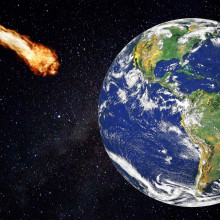
13:33 - What should we do if an asteroid heads our way?
What should we do if an asteroid heads our way?
Chris Smith put this question to astronomer Matt Bothwell...
Matt - I think the first thing just to clarify is that we do get hit by asteroids all the time. We are being bombarded by stuff from space all the time, but he general rule is that the smaller the thing is, the more common they are. If you’re looking at the really really small stuff like a grain of sand and smaller, we’re getting hit by this stuff all the time, so every day. But the bigger you go the rarer things get hit, so we get hit by say football sized things maybe once a day, but once you go up to the really really big things that get quite scary and we need to be worried about, we’re looking at every few million years or rarer. The last really big thing was 65 million years ago - it was the asteroid that wiped out the dinosaurs.
If we’re going to be on Earth for the long term, we do need to start worrying about these things and start thinking about the future. There are people that are planning for these things. I think my favourite thing about this is that the person who’s in charge of this is NASA. His job title is planetary defence officer which is like maybe they coolest this job title in the world.
We have a couple of things we can do. There’s broadly two classes of solution: we can either deflect the asteroid so just push it out the way so it doesn’t hit Earth, or we can destroy it. If we’re going to deflect it, there’s something we could do like launch something heavy at it like we’re playing a giant game of snooker and kind of hit it out of the way. Or there’s a proposal that we can kind of blast asteroids with lasers and hopefully evaporate enough mass from the asteroid that it will change its orbit that way.
There are some really ‘out there’ solutions like coating asteroids with reflective materials and letting sunlight do the the work, so if we were a coating an asteroid with something reflective then maybe the force from all the photons from the sun would eventually push the asteroid out of the orbit.
Chris - That’s called the YORP effect isn’t it: The Yarkovsy-O’Keefe-Radzievskii-Paddack effect, I believe? That's why we call it the YORP effect!
Matt - I didn’t know that - there you go! But the other alternative is also just destroying it. I think if you’re going to do that, the obvious thing to use is a nuclear weapon but it gets a bit politically tricky because there are very strict laws against using these.
Chris - It’s very dangerous as well of you start firing nukes off the planet surface?
Matt - That’s right, yeah.
Chris - So, bottom line?
Matt - We’re safe for the time being. There’s nothing anywhere near us and it’s good that we’re thinking about these things now and planning for the future.
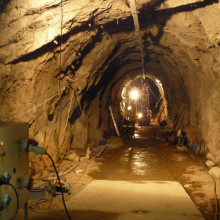
15:54 - Smarter cities: should we be building underground?
Smarter cities: should we be building underground?
Chris Smith put this question to engineer Allan McRobie...
Allan - It is one of the ways to go. The choices are to go up, go out, or go down. Go up: we’ve seen the social problems that you get from a highrise. There’s a lot of sense about going down. There’s lots of dystopian films where we’ve polluted the atmosphere and we all have to go underground. But there’s a lot of good reasons why you should put a lot of your infrastructure underground. All your cars should be underground and your trains, etc.
Elon Musk, whom you mentioned earlier, he’s got the boring company. You probably know all about his buying up tunneling machines: he’s trying to make smarter faster tunneling machines. There’s an awful lot of infrastructure you can put underground and it makes a great deal of sense.
Chris - So the answer is likely we probably will be going down as well as up? Thank you Allan!
Allan - There’s another thing as well don’t go up or down, just go out. Don’t overcrowd your cities. Spread out a bit, put your cities elsewhere. Why do we all cluster into one great megalopolis, why don’t we be a bit more decentralised? Move your studios to Salford, for example.
Chris - A bit late for a lot of that already, Allan, with the world population being what it is and 75% of people now live in cities I think, isn’t it that the statistic or at least they will do pretty soon, and the numbers of people who are moving to cities is increasing all the time?
Allan - That’s exactly right, yes. But we don’t have to.

17:32 - What's congenital heart disease?
What's congenital heart disease?
Chris Smith got the the heart of the answer to this question from Bhavesh...
Chris - So congenital heart disease is what we want to talk about. The bottom line is that these are the commonest types of congenital abnormality. I think about 1 in 200 births is affected by some kind of structural problem in the heart, and the reason this happens is because the heart is complicated and it starts to form very early on during development. A huge number of genes from your whole genome are involved in putting the heart together in the first place and, for that reason, there are a lot of things that can go wrong and so, therefore, if you have a lot of chances for things to go wrong, occasionally things do.
Some of these disorders are absolutely harmless to you and many many people don’t even know that they have a congenital abnormality with their heart. In other words, they’ve got something which is not absolutely perfect, but because the body is so adaptable it can compensate.
In other cases though, these things can be devastating. Luckily, people are getting better at diagnosing them and they’re getting better at fixing them. Diagnosing them: we can tell if there’s a family history, you might be more at risk. People also undergo studies during pregnancy - they have ultrasound scans which are non-invasive and harmless, but can pick up problems very early on in pregnancy. This means that you can be forewarned that something might need to be done for that child when it’s born so specialist teams can be on hand to make sure nothing goes wrong during the birth of the baby. Then specialist cardiac and paediatric surgeons can come in and they can actually do a lot to fix these things.
Sometimes it’s because the blood vessels are connected up to the heart the wrong way round. Other times it’s because walls that divide the chambers of the heart don’t form properly and blood can flow where it shouldn’t. These things manifest when the baby is born because when you're inside your mum, you don’t need half of the heart working because the blood is not being pumped around your lungs, it’s just being pumped around your body and so, therefore, you only find out you’ve got this problem once you’re born.
Luckily, a lot of these things can be fixed and, also, scientists are now working out the genetics of these disorders so they can screen for who might be at risk and then we can find out either how to prevent the problem occuring in the first place, or fix it afterwards.
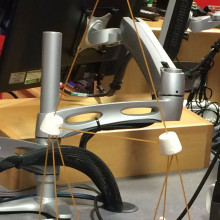
20:35 - Edible engineering - how tall can you build?
Edible engineering - how tall can you build?
with Allan McRobie - Cambridge University
Chris Smith pitted our experts Anglia Ruskin behavioural ecologist Sophie Mowles, Cambridge University astronomer Matt Bothwell and Cambridge University neurocriminologist Kyle Trieber against each other as, armed with dried spaghetti and marshmallows, they each raced against the clock to build the tallest tower. Cambridge University engineer Allan McRobie was ready to judge...
Chris - We’ve got a little competition for the panel. We’re going to put Kyle’s, Matt’s and Sophie’s construction skills to the test and engineer Allan is going to act as the judge!
Everyone’s got in front of you some spaghetti - there’s about 15 spaghetti sticks there. We’ve also given you a well known building material which Allan mentioned earlier, which is marshmallows, and you’ve got about 15 marshmallows. If you eat them, which you can do, you’ll just have less to build with.
Because what we want you to do is to build the tallest structure that you possibly can, but crucially it has to be free standing. So we’re looking for the tallest free standing structure.
You’ve got 3 minutes to do it, and then Allan will judge you.
Off you go you three. Kyle, Matt and Sophie, you three get building.
Allan, you and I can have q quick chat between us about what they ought to be doing. We’ll assume they’re not listening!
What would be a good tip for them to make the most stable structure?
Allan - As I said before, wide at the bottom - thin at the top. Triangles are good. Rectangles have the ability to rack and sheer.
Chris - Sort of change into a rhombus?
Allan - Yes, change into a rhombus. If you do see a rectangle you need to put a diagonal across it pretty quick.
Chris - And that stops the length changing?
Allan - I’m talking to Sophie.
Chris - Don’t give them too many tips. But basically, your advice would be: big wide base, and taper to a point. Why is that particular configuration particularly stable though? Why are the buildings you referenced earlier, from an engineering point of view, why are they ideal shapes and structures?
Allan - It puts the centre of gravity lower down so that makes it more stable for a start. The load gets spread out over a wider area at the base.
Chris - They’re using marshmallows and spaghetti. Is that a reasonable model for what an engineer would use in a big building? We don’t use marshmallows and spaghetti obviously - what do you tend to use?
Allan - Steel and concrete mainly. Timber’s beginning to become ever more popular now. People are trying to go higher and higher with timber. Timber’s something of a new material strangely, even though it’s been around for millenia, people are now trying to build skyscrapers out of timber.
Chris - Bamboo?
Allan - Bamboo as well, yes. There’s a lot of work about that in Cambridge. You can build amazing scaffolding out of bamboo as they do in the Far East. It goes right up the side of the skyscraper all out of bamboo.
Chris - Of course, the benefit of using bamboo for your scaffolding is that it’s much lighter than if you use big steel poles. Instead of having to have very big steel poles to support the weight of even more big steel poles, you are able to make the whole structure much lighter.
Allan - Yes, you’re right. Then it’s all about the joints with the bamboo, because the bamboo is incredibly strong but then you have to tie it together somehow.
Chris - Right well, time up. You have to stop building I’m afraid team. Allan, what are your thoughts? Shall we ask each of them? Kyle could you just talk us through your construction?
Kyle - Yeah, sure. It looks something like a drunken camel. I’ve got four big marshmallows on the base and then they’re tapering up to two, so you can imagine the four hooves going up to the front and back of my camel. There’s a body in between which is made out of one of these noodles, and then there’s one single neck going up that didn’t go anywhere because I ran out of time. I would suggest that this is not the best building material.
Chris - Allan, your critique?
Allan - It’s nice; I like the camel. I think it’s got artistic merit. It’s up to the second layer. There’s some triangulation going on.
Chris - So we’re looking probably about 30 cms of height for Kyle there?
Allan - 50.
Chris - You’re going as high as 50. I think you’re adding a bit on there. Okay, 50.
Matt, what have you got in front of you? Yours is much taller.
Matt - It’s still something of a monstrosity I think. I think it’s something maybe from War of the Worlds.
Chris - Describe this for everyone.
Matt - It’s a couple of tripods which are held together by a kind of crossbeam and a triangle on top. Then I’ve got a completely unnecessary extra couple of centimetres of spaghetti to just try and get some extra height.
Chris - Allan, your verdict?
Allan - It’s very good. The tripods are naturally stable. I’m sure there would have been three tripods had there been more time and more marshmallows. I like the little thing on the top. Lots of real buildings do that, they put a little arial on the top just to get a bit higher in the Guinness Book of Records
Chris - The Shard in London is a classic example isn’t it? The top bit is completely impractical - all aesthetic.
Allan - Most of the buildings do that, yes.
Chris - Sophie?
Sophie - Mine is leaning against my microphone! It looks like the Eiffel Tower has melted. Yeah, I ignored Allan’s advice about the crossbeam and I thought I’d cheat by eating off half the marshmallows to create a stable, sticky structure - but it didn’t work.
Chris - Allan?
Allan - There’s a lovely tetrahedron at the top, which has got all the triangles everywhere so it’s really nice and rigid. But the lower part has got lots of rectangles and they've all just twisted so, sadly, the top is standing up on a twisted, mangled lower storey.
Chris - Yeah. It’s almost like Sophie’s tall building is resting on another tall building next door which wouldn’t have the designers of that building terribly happy, would it?
Who wins in your view Allan?
Allan - I think I have to give it to Matt. He did cheat a little bit by adding the little arial, but that’s how you win this game!
Chris - Well there you go. Matt, your are this week’s Engineer of the Week!
Matt - Thank you so much.
Chris - Very well done!

25:35 - Why send a probe to the sun?
Why send a probe to the sun?
Chris Smith put this question to astronomer Matt Bothwell...
Matt - This is the Parker Solar Probe, which is going to be launched this summer - August 2018 it’s planned to go up. It’s basically going to let us answer loads of questions about our Sun that we don’t understand at the moment. It sounds a bit weird, right, that we might not not understand things about our Sun. We’ve been observing it for hundreds and hundreds of years, but there are quite a lot of mysteries about the Sun and there are things that we’d like to clear up.
One of the really big ones is what we call the Coronal Heating Effect. It’s one of the big unsolved mysteries in physics. The corona around the Sun - if you can think of it like the Sun’s atmosphere - it’s all this superheated plasma around the Sun. The weirdest thing is it’s much much hotter than the solar surface. The surface of the Sun is maybe a few thousand degrees, and the corona is millions of degrees, which seems to violate thermodynamics. You can’t have something cooler heating something hotter! So there has to be something quite weird going on, maybe involving magnetic fields that we don’t understand.
What the probe is: it’s going to be the first thing that’s actually going to visit the star. It’s actually going to go into the corona and take measurements, and let us solve these kinds of problems. It’s not, of course, just the coronal heating problem. It’s going to help us better understand the solar winds which is going to let us learn how to protect our satellites better and also is going to have implications for understanding how we can make spacecraft to launch humans into the distant solar system.
Chris - What’s the timescale over which this is all going to be happening?
Matt - It’s launching August this year. I think it will take a few years to get to the Sun. It’s going to do various flybys around the solar system to build up exactly the correct speeds to descend into the Sun, but it’s going to be a few years before it actually gets there...

27:25 - Could brain stimulation make us criminals?
Could brain stimulation make us criminals?
Chris Smith put this question to neurocriminologist Kyle Treiber...
Kyle - I think the first thing we have to do when we start to think about crime is to remember that it’s a behaviour. It’s a very complex phenomenon and something that is the culmination of a decision making process. When we’re talking about stimulating the brain and activating emotions, those are one element that would go into that decision making process.
You can look at this question in a number of different ways but I’m going to look at it from the perspective of making people want to commit crime, so we’re looking at motivation here. We’re looking at perhaps these emotional processes increasing your anger against someone who may have split their drink on you or bumped into you. Or maybe increase your temptation towards an object that you want. Something in a shop that maybe you want to steal.
We have these motivations but, of course, there’s lots of ways that people can respond to those motivations. The way that they respond will be based on their experiences that they’ve had previously which will lead them to remember certain types of behaviour that have been successful. They’ll have seen other people’s behaviour and so they will have learned different ways they can respond this. And, in the vast majority of cases, thankfully, most of us don’t see crime as a way to satisfy our motivations. In some cases yes, people will do that, and that may be because of the experiences they’ve had before. But, even if we can increase that motivation, it’s not going to increase the chance of these people seeing crime as first, the option that they might consider. And then, of course, down the road to the decision making process itself, the one that they choose amongst the other alternatives they may see.
We tend to think about that decision making process in this kind of rational way with lots of different options and evaluation, and considering consequences. There is another type of behaviour which is habitual behaviour and habitual behaviour happens when you’ve done something over and over again and you’ve developed a habit. You’ve been in a situation or this place before, you’ve acted a certain way. It worked great for you the first time in previous experiences so, sure, you’re just going to do that again. The can be more automatic type of behaviours.
We haven’t studied enough of these habitual behaviours in criminology but likely they are influencing a lot of this persistent crime that we see, which is one of the most problematic aspects of crime. It’s possible then that these could be stimulated more easily with a more simplistic framework than these deliberate processes, but that would be the closest you would get to it. But I still think it’s such a complex type of behaviour that all we can do is perhaps influence some of the information that goes into that process.

30:32 - Testing our panels' metal: quiz time
Testing our panels' metal: quiz time
with Dr Sophie Mowles, Anglia Ruskin University, Allan McRobie, Cambridge University, Dr Kyle Treiber - Cambridge University, Dr Matt Bothwell - Cambridge University
Chris Smith put our panel - astronomer Matt Bothwell, engineer Allan McRobie, neurocriminologist Kyle Treiber and behavioural ecologist Sophie Mowles - to the test with a Naked Scientists quiz...
Kyle and Matt, you’re team 1
Sophie and Allan, you are team 2
ROUND 1 - BIRDS AND BEES
Q1: Chris - team 1 [Kyle and Matt]:
Which can exert more force - the kick of a secretary bird or the pinch of a coconut crab?
Kyle - I think it’s the coconut crab.
Matt - It has to be crabs, right? Crustaceans are famous for being able to do these really forceful pinches, aren’t they?
Kyle - Yeah. Although some birds are known for having very hard kicks but…
Matt - Interesting! Yeah, I reckon the crab.
Kyle - Go with the crab.
Correct answer: the coconut crab!
It lives in the tropical Indian and Pacific oceans, and as their name suggests, they’re strong enough to open coconuts! The pinch can exert a force comparable to a boxer’s punch. But the secretary bird’s kick isn’t to be underestimated! These gangly birds have been known to deliver killer kicks with a force equivalent to 5 times their body weight.
Q2. Chris: Team 2 [Sophie and Allan]:
What is more poisonous, a cone snail or a daddy long legs?
Allan - Cone snails are very very poisonous but it’s got to be a trick question hasn’t it? Is this the fact that the daddy long legs can’t pierce your skin or is that an urban myth?
Sophie - I think that’s an urban myth. It depends on how you define daddy long legs as well which can be many many things. It could be the spider or the cone snail. They are very venomous.
Allan - It’s too easy to be the cone snail - it’s got to be a trick question! It’s got to be the cone snail, therefore that’s going to be the wrong answer.
Chris - What would you like to go for, the snail or the daddy long legs?
Sophie - I’d like to go for the cone snail. I think it’s right.
Chris - It’s the right decision!
Answer: Cone snail
Info: Cone snails are predatory, sea-dwelling snails you do not want to tread on. The estimated lethal dose to humans of the Geography cone snail is less than 0.1mg per kg, so say you’re 80kg, that’s 8mg!
Daddy long legs being poisonous, on the other hand, is a total myth. There are 3 species of creepy crawlies that people refer to as daddy long legs. 2 of these - the harvestman and the crane fly - have no venom at all, and for the other one, the pholcid house spider, can give you a nip, but the venom wouldn't harm a human.
ROUND 2 - UP, UP AND AWAY
Q3. Chris: Team 1[Kyle and Matt]:
Assuming no impact from space debris, what’s going to survive longer in space? Starman’s tyres, or his windscreen?
Starman is Elon Musk’s Tesla that he blasted into space last week aboard the Falcon Heavy, and it’s currently on its way having missed its target of Mars to the asteroid belt. So it’s car is making its way across space - what’s going to last longer the windscreen, or the tyres?
Kyle - I might have to defer to Matt on this one.
Matt - Assuming no impact from space debris is the confusing thing right, because I assume there would be this constant rain of stuff that would wear things away? Does rubber decay over time?
Kyle - I would have thought rubber would be more resilient than glass, assuming the windscreen is made of glass in this case.
Matt - This is assuming it’s not getting hit by stuff, right?
Kyle - Yeah.
Matt - We’ll guess windscreen.
Answer: The glass in the windshield.
Solar radiation breaks carbon-carbon and carbon-hydrogen bonds, for instance in the rubber car tyres, whereas glass is in-organic, made mainly of silica (SiO2), so the glass will probably be more resilient. BUT - windscreen glass is laminated with plastic, so it will still discolour and come apart at some point. So the glass is not completely immune to the solar radiation but it will probably be a bit more resilient than the tyres.
Q4: Chris: Team 2 [Sophie and Allan]:
How many Earths could you fit in the distance between the earth and the moon? 10, 30 or 1000?
Sophie - There’s some calculations going on.
Chris - What are your thought processes?
Allan - I’m trying to do the maths!
Sophie - I’m just watching.
Allan - Is it about a quarter of a million miles to the Moon, is it? Is that right? And is it the diameter…
Chris - Metric on this show please. We haven’t left the EU yet!
Allan - The diameter of the Earth is 12,000 kilometres and…
Chris - Going to have to push you, 10, 30 or 1000?
Sophie - Not a thousand.
Allan - It’s got to be 30.
Sophie - Shall we?
Allan - Yes.
Answer: 30. On average, the moon is 380,000 kilometers away from the Earth, and the diameter of the Earth is 12,756km. So - a bit of division later and we end up at 30 Earths about.
ROUND 3 - HIT ME ONE MORE TIME
Q5 Chris: Team 1[Kyle and Matt]:
Hit with an identical force, what accelerates the fastest: a) Cotton wool ball b) Golf ball c) Football OR d) All the same…?
Matt - I think this about elastic versus inelastic collisions right?
Kyle - I vaguely remember that from my physics class.
Matt - I think it would be a golf ball.
Kyle - That’s the initial response…
Kyle - I’m going to go with your golf ball but I’m wondering...
Chris - Are you going to go golf ball? You got a no no for that one.
Answer: The cotton wool ball!
Newton’s 2nd law of motion is Force = mass x acceleration; so acceleration is force divided by mass. So the lightest object - the cotton wool - will accelerate the fastest. It won’t have much momentum though, and will feel a lot of air resistance, so it won’t travel very far…
It was a bit of sneaky question. Let’s hope they get this one wrong and then you’ll stay in the game.
Q6: Chris: Team 2 [Sophie and Allan]:
In a glass filled with ice and water to its brim, when the ice melts, will the water level in the glass: a) drop, b) stay the same or c) overflow?
Chris - What do you think?
Sophie - Up to its brim. So then it would drop because ice is greater in volume than water, so once the ice melts, as long as it’s up to the glasses brim, the level will drop.
Allan - Yeah. Let’s go with that.
Chris - So you’re saying the levels going to drop?
Sophie - Yep.
Answer: stay the same.
The ice is made of water, so it’s only displacing, or pushing out of the way, a volume of water equivalent to its own mass; hence the level of water won’t change when the ice melts.
TIE BREAKER
Chris - To the nearest 10, how many balloons can the current Guinness World Record holder blow up in an hour? Through the power of puff alone.
Matt - 1,400.
Chris - And Allan and sophie?
Allan - We had 1,000.
Answer: 910
Info: According to the Guiness Book of World Records, Hunter Ewen from Colorado trained for 6 months, worked with a surgeon to get the most efficient balloon-tying technique, and even worked on techniques for conserving air and avoiding getting light-headed. Even then, during his record setting feat he experienced tingling in his hands and changes in eyesight!
Chris: That means the points go to Sophie and Allan. So well done! That enables you to clinch victory from the jaws of defeat and you are this week’s Big Brains of the Naked Scientists!

38:23 - Do animals cheat on each other?
Do animals cheat on each other?
Chris Smith put this question to behavioural ecologist Sophie Mowles...
Sophie - Well actually, yes. For the most part in the animal kingdom polygamy is the name of the game so animals mate multiply. From a male’s perspective that makes sense because, as I said earlier, sperm is cheap to make; they're very small cells and males can fertilise multiple females. So, from an evolutionary standpoint, in getting genes into the next generation for many animals it makes sense for males to mate multiply.
But that doesn’t mean that the females are losing out because females can mate multiply too. They can mate once and get some genes for their offspring, but they could maybe mate twice and get some better genes for their offspring. In some animals, females can store sperm so they can actually let sperm competition sort it out.
Chris - Bees do that don’t they? I was gobsmacked when a bee expert when I interviewed him at the University of Western Australia said that the queen bee, in some cases, mates once and can store sperm for years and continue to fertilise offspring from that one-off mating with many many males.
Sophie - Indeed. In the hive, that’s her family; they’re all very genetically related to her. She won’t want to mate with any males that enter that hive because they’ll be her sons. But yeah, many insects can store sperm for a long time. It’s not a bad thing if you then mate with another male because you might get some new sperm, or better ones so you get better quality offspring. They may be compatible genes as well which makes for better offspring too, or you might be able to provision them with different immunities so if a disease breaks out you don’t lose all of your offspring because you’ve mated with multiple males who offer different immunities through their genes.
But you do get genuine cheats as well. Some animals can offer nuptial gifts as a kind of mating gift to a female.
Chris - Like what?
Sophie - Food is a good nuptial gift.
Chris - It always works - food. It’s a sure fire winner.
Sophie - Food, flowers, that sort of thing. Food is great because females have to produce offspring so they need a lot of energy to make a baby or an egg so males can give females nuptial gifts involving food. There are some famous examples in spiders where they wrap the gift in silk, and the female has to unwrap it and while she’s unwrapping the gift he gets to mate with her.
Chris - Unwrap a present?
Sophie - Unwrap a present. So the more well wrapped the present is the longer the mating. He transfers more sperm but some of these cheating male spiders wil wrap something that isn’t actually food.
Chris - Aww, that’s awful!
Sophie - So a bit of a leaf or a twig that he’s found and that’s a real cheat really.
Chris - Does the female pay him back by eating him which seems to be what most spider females do the male?
Sophie - If he’s not quick enough, then yes that can happen.
Chris - How quickly does she discover and become disappointed?
Sophie - Well, it will be on unopening of the gift but sometimes males want to be eaten; some spiders once they’ve mated twice they lose the ability to mate again so they may as well sacrifice themselves and then the protein that makes their bodies will make more eggs containing their genes so that ultimate sacrifice can be really good for him.

41:43 - Can we make a gravity shield?
Can we make a gravity shield?
Chris Smith put this question to astronomer Matt Bothwell...
Matt - I really like this question. Gravitational shielding is this science fiction idea that you could create some kind of exotic material and it would shield the force of gravity so you could effectively use that to reduce the weight of objects which will have all kinds of amazing applications, as you can imagine, if you want to make really tall buildings. For example, you can make the construction materials weightless and just levitate them up.
Chris - That would be lovely wouldn’t it? Climbing the stairs would be a gift - it would be easy.
Matt - We already have experience with shielding forces. Gravity is one of the four fundamental forces of the universe and we already know how to shield one of the other fundamental forces of the universe which is electromagnetism. Electromagnetic shielding is pretty common in our phones and in our computers, and our microwave doors are electromagnetically shielded. It’s good that they are because then we don’t cook ourselves every time we turn our microwaves on.
Unfortunately, gravity and electromagnetism are pretty different and, as far as we know, we can’t build gravitational shieldings. There have been lots of experiments through the 20th century to investigate whether this is possible and they’ve all come up negative so, as far as we know, it’s not actually possible.
I think one easy thought experiment that you can prove to yourself that it would be impossible is that it would violate something called “conservation of energy,” which is one of the fundamental rules in science. If you can imagine having some sheets of gravitationally shielding material, you could put this sheet under a very heavy object. Then this object would become weightless and you could lift it up in the air with ease, and then you could just quickly whip the sheet away and the heavy object would come crashing down to earth and release loads of energy, and all that energy has just come from absolutely nowhere. If anything gives you something for nothing in this way we have reasons to be suspicious.

43:48 - How is Cape Town running out of water?
How is Cape Town running out of water?
Chris Smith put this question to engineer Allan McRobie...
Allan - It’s a problem that many cities face, particularly in hot countries. I don't want to ascribe any blame to Cape Town people, because I’m not that familiar with the problem, but it does look like a case of bad planning; every city knows that it needs a certain amount of water. One thing you should be clear about is a distinction between the residential uses for drinking and washing and so forth, as opposed to agricultural uses, particularly in hot countries that could be irrigation, or industrial uses. Those latter ones are the big users of water in hot countries. Many, many times more than the cities there.
I don’t know what’s happened in Cape Town in that respect. I know they’ll be wineries, there’ll be farms around Cape Town, they will have taken water and I don’t know what they’re going to do about that. Obviously, you don’t want all your vineyards to die, the farms are needed but usually it’s a comparatively small amount of water that you need to keep a city going, and one thing you can do is bring it in from somewhere else. In South Africa the have the Lesotho Highlands water scheme, which is the neighbouring country Lesotho, where they bring water from the dams and the mountains there, but they take those to the industrial areas elsewhere north of South Africa. I don’t think that gets down to Cape Town, but it really shouldn’t have happened. Many cities face this, even London and Miami - there’s a big list - Perth in Western Australia. There’s lots of cities face this problem but you just plan for it.
Chris - The thing that concerns me though is if you look at the reports of South Africa, there’s a gentleman who drills boreholes, and he says he normally has five or six on his books at any one time waiting for a borehole. He’s now got 6,400 waiting for boreholes so everyone’s making their own salvation here, digging a borehole. This is going to to deplete the groundwater, we’re just kicking the can down the road aren’t we because we have not solved the underlying problem which is a very big aggregation of people and insufficient water gathering in that particular area to service them?
Allan - That’s absolutely right. The groundwater’s very rapidly depleted if you start to pump it up and, as happened in many places around the world, you really need to have a bigger approach to the problem. You see the Chinese: the South/North water transfer project where they take in vast quantities of water, I think from the Yangtze, and taking it thousands of miles North up to Beijing. There are many schemes like this around the world. There’s a proposal to run a pipeline from a river in Turkey over to northern Cyprus that’s very dry.
There are places in the world with lots of water and it can be transferred. There’s also, of course, the concept of virtual water, that you import chocolate or whisky are very intensive, so don’t make your own because there’s thousands and thousands of litres of water goes into one litre of whisky so buy the one litre of whisky rather than bringing it in. The same applies to tomatos or all the way down. You can bring in the water- intensive things rather than trying to grow it yourself. Let the people with the water grow it.
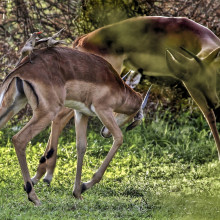
47:08 - Back off mate: which animals are aggressive with love rivals?
Back off mate: which animals are aggressive with love rivals?
Chris Smith put this question to behavioural ecologist Sophie Mowles...
Sophie - There are some uber aggressive animals but they are very rare to be honest. Over evolutionary time we have seen the adaptation for conflicts, largely between males in order to access females. But, realistically, if you go and get yourself really badly injured in a fight, or even killed, you’re not going to pass any genes on so we see a real reluctance to use these weapons. For example, deer interlock their antlers and they have pushing contests, that’s after they’ve roared to demonstrate their size and their stamina, they don’t just stab each other with them. We see what’s called restrained fighting and “fighting” tends to be resolved via communications, especially when there’s a likelihood you’ll get really hurt.
However, if it’s really worth fighting for, if you’ve got a really good quality resource, and that in genetic terms would be a lot of females, then you do tend to see really dangerous conflict, and a good example of this are elephant seals. These fight hammer and tongue for access to a whole harem of females on a beach. If you’re a weakling male just not competitive, it’s just not worth fighting, so you're not going to have any offspring. If you try to take on the big dominant male, you’d just get really terribly injured or killed. If however, you might have a chance of taking him on if you’re possibly the same size or strength, then you can get incredibly vicious fights because you could have all of these females, and pass all of your genes on, and have lots of offspring. Losing that fight is almost the same as being that weakling male. In each case you don’t get any genes going into the next generation so it’s really really worth fighting for if you’ve got a chance. You can get really bloody encounters between these guys.
Chris - One interesting perspective that was put to me about ten years ago by a lady I interviewed who’d been studying deer in Scotland - her name was Luska Crook. She pointed out that actually the genes that make for a really big powerful male deer are not going to be the best genes, if they end up in a female offspring, to nurture a baby because these animals are sexually dimorphic. The males are quite different to the females, and this is quite a crafty way of keeping the diversity in the population because the males are not made too masculine because those genes would disadvantage a female offspring and visa versa. So it sort of keeps everyone a bit in check but there is still a difference between males and females.
Sophie - Yes. Genes, obviously, get transferred into the offspring whether they come from the male or the female, so if you have a daughter she will inherit genes for male characteristics too and could then transfer those onto her son when she eventually has that.
In deer, for example, a male may inherit the genes that determine his antler structure from his mum because they came from his grandfather. We tend to see this also in other sexually selected traits for example, famously in peafowl, in peacock, as you said earlier has this enormously elaborate train. The female however does not; she’s fairly drab. She has to incubate - he does nothing. He give her his genes but she has to do the work of looking after the eggs so she has to be cryptic and camouflaged, but she has still inherited some of those male traits. It has a bit of glossiness and that might be an evolutionary bind; she’s still a little bit spotable when she’s on the nest.
For example in the UK there’s ducks. The males are really nice and shiny and elaborate to show how good they are; they don’t do anything to help with the childrearing. Females have to incubate so they’re camouflaged because they’re a “sitting duck”; they’re really vulnerable.
Chris - You got there; beat me to it!
Sophie - Sorry, but that’s the punchline! If you look at birds, the British birds are great for this. Look at your wildfowl: if they look drastically different so the male is very colourful and the female is not, you can bet your bottom dollar she’s looking after the offspring and he’s not. If you get monogamy, Grebes for example, they look the same because they’re both having to prove to one another how good they are, and they both benefit from investing in those offspring and bringing them up together.

Do you feel guilty?
Chris Smith put this question to neurocriminologist Kyle Treiber...
Kyle - There’s a couple of things that might make me, or other people like me, more likely to feel more guilty. One of them is, potentially, our emotional capacity so if we are emotionally reactive then we’re more likely to experience our emotions more strongly. But even beyond that element, there’s also the learnt aspect of it and, of course, our emotions are very closely tied to our memories. A lot of our application of these emotions will depend on our experiences and what we’ve learned so, a much as I love my mother, she’s given me a lot of guilt trips. I think definitely I’ll carry that on and I’ll definitely try not to do that to my own children.
But we feel very differently about the behaviours. We talk in criminology about the idea of rules and, of course, crime is a type of behaviour that breaks the rules, specifically the rules of law. But we’re interested in other kinds of deviants that might break more social norms that aren’t as formalised of rules. The guilt and also shame, which is a related emotion help to strengthen those rules so if we think that something’s wrong, we might not care about doing the right thing because we don’t feel very strongly about it, so the emotions back that up. If we think it’s wrong, and then we’re also to feel particularly guilty or ashamed about it then that rule is going to be stronger and we’re more likely to follow it.
I think a lot of the variation when you think about people feeling guilty about crime may not actually be a variation in their feelings and their emotions, but rather a variation in the rules that they think they should or shouldn’t follow. If they don’t think it’s wrong it doesn’t matter if they have strong emotions about it because they don’t care about doing the wrong thing. They don’t see that as wrong so the guilt won’t feed into, won’t be part of that decision making or eventually that crime.

53:38 - How do we know that bridges will stay up?
How do we know that bridges will stay up?
Chris Smith put this question to engineer Allan McRobie...
Allan - You can be fairly confident about it. It’s been designed by a structural engineer and then checked independently by quite a few others. When you would not be quite so certain is if it’s a fairly innovative bridge that is a type we haven’t seen before. There’s a thing in reliability theory called the bathtub curve I think they call it, which says if something's going to fail it sort of fails either early on on day one or two, or it’s going to be a long time, many years.
The early failures are there’s some dodgy detail or there’s a bad bit of design and you don’t really know till you’ve built it and then load tested it, so don’t go on bridges on their opening day is a general rule. If it makes the opening day, it’s going to be fine on day two, day three, etc. But then after several decades you start to get corrosion, you get fatigue, cracks will open up, etc., you’ll get material degradation. So then it becomes more likely to fail but we do have good bridge inspection regimes.
For really long bridges the hardest thing is keeping it there in a hurricane or a storm. It’s all about the wind design. It’s quite easy to hold a traffic jam in the air for several kilometres, you just need really big cables, but to hold it there during a hurricane is a really difficult piece of engineering, the way the structure and the wind talk to each other. And so don’t go on big bridges in hurricanes. You would be blown off .
Chris - How does an engineer, like you, anticipate and model that sort of scenario? Do you have a computer programme that pretends its got the bridge sitting there and can work out all of the forces a bridge would be feeling in said hurricane, for example? Is that how you do this?
Allan - You do both. We do it on the computer and in the wind tunnel. You make scale models of it in the wind tunnel but we know have fairly sophisticated computational wind tunnels and the real difficulty is the wind. If you’re looking at the bridge, you’re looking at the wrong thing. We really need to understand the wind and all the swirls and vortices and the forces that it creates out of nowhere. It makes the bridge move a bit. There’s a feedback system. It’s really very complicated and, in fact, because I know how complicated it is I’m not all that certain that we should be quite so confident that we know what we’re doing. We are very confident but we want one in a million chance that this is going to go wrong. Whereas I sometimes struggle to put the figures quite so high because it is really difficult physics.
Chris - Because things do end up needing changes don’t they? If you look at the Tate Modern bridge in London, it was a bit of an oversight wasn’t it on the part of the engineers that people were actually going to walk across this bridge? And it’s once people began walking across it that it set up resonances on the bridge and the whole thing was swaying from side to side and they had to stabilise it. Did no-one actually think someone’s going to use this bridge when they were testing it and building the model?
Allan - No they did, and it’s quite an interesting one. The fundamental physics there is actually biology. It’s about the people and not about the bridge, it’s the way that people change the way they walk. There was a feedback and the people behaved like a fluid and as the bridge moved a bit they changed the way they walk. But that really demonstrated the day one phenomenon that the most telling thing was when they first put the crowds on it. That was a real load test. I told my family don’t go on it that day. It’s a load test, it’s an experiment.
Related Content
- Previous How do planes stay in the air?
- Next Crime scene genes










Comments
Add a comment